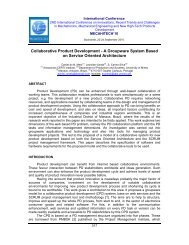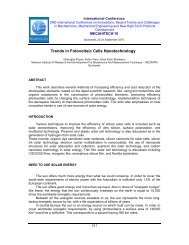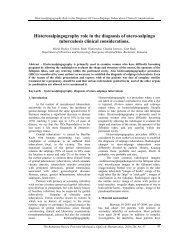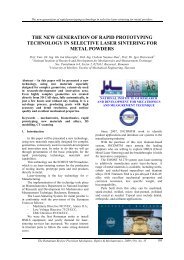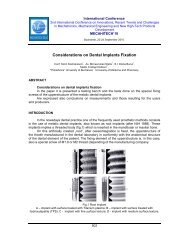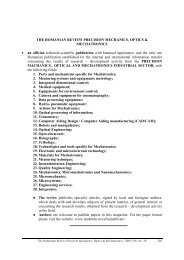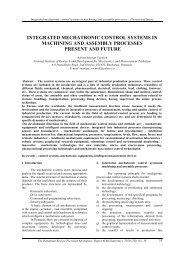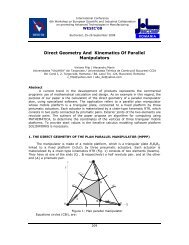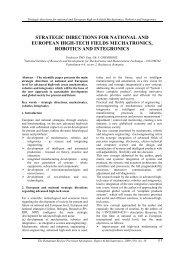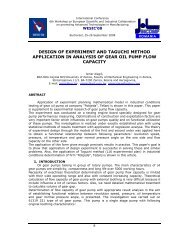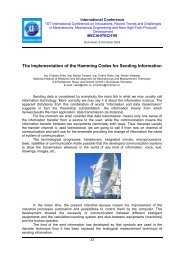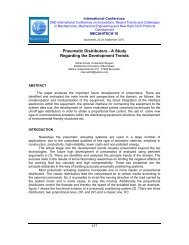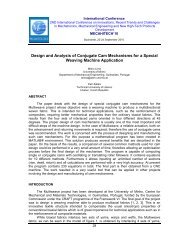PAPER TITLE - incdmtm
PAPER TITLE - incdmtm
PAPER TITLE - incdmtm
You also want an ePaper? Increase the reach of your titles
YUMPU automatically turns print PDFs into web optimized ePapers that Google loves.
Proceedings of International Conference On Innovations, Recent Trends And Challenges In<br />
Mechatronics, Mechanical Engineering And New High-Tech Products Development –<br />
MECAHITECH’10, vol. 2, year: 2010<br />
New Technologies for Building Complex Prosthetic Elements<br />
from Biocompatible Metals<br />
Dan Ciobota 1 , Comsa Stanca 1 , Adrian Pacioga 1 , Doina Gheorghiu 1 , Deniz Demirtas 2<br />
1 National Institute of Research & Development for Mechatronics and Measurement Technique,<br />
6-8 Str. Pantelimon, Bucharest, Romania,<br />
dan_ciobota@yahoo.com<br />
2 EOS - Electro Optical Systems GmbH, Germany<br />
ABSTRACT<br />
This research paper is based on the national project “Studies on complex therapeutic<br />
alternatives (including Prosthetics Prototypes) for patients with respiratory disorders during sleep in<br />
order to improve quality of life and socio-professional reintegration” financed by National Centre for<br />
Programme Management (CNMP) accepted under the acronym of the project: SASPROT and contract<br />
number: 61-033/2007. The NIRDMMT-National Institute of Research and Development for<br />
Mechatronics and Measurement Technique, Bucharest, Romania develop a mandibular advancement<br />
device for the treatment of snoring and sleep apnea. It is a custom-made that snaps firmly and<br />
comfortably over the upper and lower teeth. The new technologies based on rapid prototyping<br />
techniques allow the high degree of customization for each patient.<br />
Keywords: respiratory disorders during sleep, prosthetic prototypes, rapid prototyping &<br />
manufacturing, selective laser sintering, 3D design.<br />
SELECTIVE LASER SINTERING<br />
Selective laser sintering (SLS) (fig.1) is an additive manufacturing technique that uses a high<br />
power laser (for example, a carbon dioxide laser) to fuse small particles of plastic, metal (Direct Metal<br />
Laser Sintering), ceramic, or glass powders into a mass representing a desired 3-dimensional object.<br />
The laser selectively fuses powdered material by scanning cross-sections generated from a 3-D digital<br />
description of the part (for example from a CAD file or scan data) on the surface of a powder bed.<br />
After each cross-section is scanned, the powder bed is lowered by one layer thickness, a new layer of<br />
material is applied on top, and the process is repeated until the part is completed.<br />
Compared to other methods of additive manufacturing, SLS can produce parts from a<br />
relatively wide range of commercially available powder materials. These include polymers such as<br />
nylon, (neat, glass-filled or with other fillers) or polystyrene, metals including steel, titanium, alloy<br />
mixtures, and composites and green sand. The physical process can be full melting, partial melting, or<br />
liquid-phase sintering. And, depending on the material, up to 100% density can be achieved with<br />
material properties comparable to those from conventional manufacturing methods. In many cases<br />
large numbers of parts can be packed within the powder bed, allowing very high productivity.<br />
Fig. 1 Synthetic representation of a SLS system and final product build through selective laser<br />
sintering<br />
102
Proceedings of International Conference On Innovations, Recent Trends And Challenges In<br />
Mechatronics, Mechanical Engineering And New High-Tech Products Development –<br />
MECAHITECH’10, vol. 2, year: 2010<br />
SLS is performed by machines called SLS systems. SLS technology is in wide use around the<br />
world due to its ability to easily make very complex geometries directly from digital CAD data. While it<br />
began as a way to build prototype parts early in the design cycle, it is increasingly being used in<br />
limited-run manufacturing to produce end-use parts. One less expected and rapidly growing<br />
application of SLS is its use in art. The main use of Rapid Prototyping systems are presented in fig.2.<br />
Fig. 2 Main use of Rapid Prototyping systems<br />
SLS was developed and patented by Dr. Carl Deckard at the University of Texas at Austin in<br />
the mid-1980s, under sponsorship of DARPA. A similar process was patented without being<br />
commercialized by R.F. Housholder in 1979.<br />
DIRECT METAL LASER SINTERING<br />
Direct metal laser sintering (DMLS) is an additive metal fabrication technology developed by<br />
EOS out of Munich, Germany. The process involves use of a 3D CAD model whereby a .stl file is<br />
created and sent to the machine‟s software. A technician works with this 3D model to properly orient<br />
the geometry for part building and adds supports structure as appropriate. Once this „build file‟ has<br />
been completed, it is „sliced‟ into the layer thickness the machine will build in and downloaded to the<br />
DMLS machine allowing the build to begin. The DMLS machine uses a high-powered 200 Watt Ybfiber<br />
optic laser. Inside the build chamber area, there is a material dispensing platform and a build<br />
platform along with a recoater blade used to move new powder over the build platform. The<br />
technology fuses metal powder into a solid part by melting it locally using the focused laser beam<br />
(fig.3). Parts are built up additively layer by layer, typically using 20 micron layers. This process allows<br />
for highly complex geometries to be created directly from the 3D CAD data, fully automatically, in<br />
hours and without any tooling. DMLS is a net-shape process, producing parts with high accuracy and<br />
detail resolution, good surface quality and excellent mechanical properties. The controlled dosing mini<br />
equipment, allows a wide use like portable ambulatory mini equipment variant and as monitoring mini<br />
equipment for research and implementation of a new treatment in medical departments.<br />
Fig. 3 Schematic representation of the three phases of the process: powder laser sintering final<br />
part<br />
103
Proceedings of International Conference On Innovations, Recent Trends And Challenges In<br />
Mechatronics, Mechanical Engineering And New High-Tech Products Development –<br />
MECAHITECH’10, vol. 2, year: 2010<br />
A number of different materials are available for use with EOSINT M systems, offering a broad<br />
range of e-Manufacturing applications. EOS CobaltChrome MP1 is a multi-purpose cobaltchromemolybdenum-based<br />
superalloy powder which has been optimized especially for processing on<br />
EOSINT M 270 systems. Other materials are also available for EOSINT M systems, including a<br />
special-purpose cobalt-chrome-molybdenum-based superalloy for dental veneering application, and<br />
further materials are continuously being developed.<br />
EOS CobaltChrome MP1 for EOSINT M 270<br />
Description, application<br />
EOS CobaltChrome MP1 is a fine powder mixture for processing on EOSINT M 270 systems,<br />
which produces parts in a cobalt-chrome-molybdenum-based superalloy. This class of superalloy is<br />
characterized by having excellent mechanical properties (strength, hardness etc.), corrosion<br />
resistance and temperature resistance. Such alloys are commonly used in biomedical applications<br />
such as dental and medical implants (note: widely used in Europe but much less so in North America),<br />
and also for high-temperature engineering applications such as in aero engines.<br />
The chemistry of EOS CobaltChrome MP1 conforms to the composition UNS R31538 of high<br />
carbon CoCrMo alloy. Parts built from this material are nickel-free (
Proceedings of International Conference On Innovations, Recent Trends And Challenges In<br />
Mechatronics, Mechanical Engineering And New High-Tech Products Development –<br />
MECAHITECH’10, vol. 2, year: 2010<br />
[1] Based on users' experience of dimensional accuracy for typical geometries, e.g. ± 20 μm when<br />
parameters can be optimized for a certain class of parts or ± 50 μm when building a new kind of<br />
geometry for the first time.<br />
[2] For larger parts the accuracy can be improved by post-process stress-relieving at 1150 ºC for 6<br />
hours.<br />
[3] Mechanical stability is dependent on geometry (wall height etc.) and application<br />
[4] Volume rate is a measure of build speed during laser exposure. The total build speed depends on<br />
the average volume rate, the recoating time (related to number of layers) and other factors such as<br />
DMLS-Start settings.<br />
Fig. 4 The software used for solid modelling<br />
Solid Works (SW) is used of solid modelling techniques that allows for the automation of several<br />
difficult engineering calculations that are carried out as a part of the design process (fig.4). Simulation,<br />
planning, and verification of processes such as machining and assembly were one of the main<br />
catalysts for the development of solid modelling. More recently, the range of supported manufacturing<br />
applications has been greatly expanded to include sheet metal manufacturing, injection moulding,<br />
welding, pipe routing etc.<br />
Beyond traditional manufacturing, solid modelling techniques serve as the foundation for rapid<br />
prototyping, digital data archival and reverse engineering by reconstructing solids from sampled points<br />
on physical objects, mechanical analysis using finite elements, motion planning and Numerical Control<br />
(NC) path verification, kinematic and dynamic analysis of mechanisms, and so on. A central problem<br />
in all these applications is the ability to effectively represent and manipulate 3 dimensional geometry,<br />
in a fashion that is consistent with the physical behaviour of real artifacts. Solid modelling research<br />
and development has effectively addressed many of these issues, and continues to be a central focus<br />
of computer aided engineering.<br />
Fig. 5 Parts build on SolidWorks<br />
Building a model in SolidWorks usually starts with a 2D sketch (although 3D sketches are<br />
available for power users). The sketch consists of geometry such as points, lines, arcs, conics (except<br />
105
Proceedings of International Conference On Innovations, Recent Trends And Challenges In<br />
Mechatronics, Mechanical Engineering And New High-Tech Products Development –<br />
MECAHITECH’10, vol. 2, year: 2010<br />
the hyperbola), and splines. Dimensions are added to the sketch to define the size and location of the<br />
geometry. Relations are used to define attributes such as tangency, parallelism, perpendicularity, and<br />
concentricity. The parametric nature of SolidWorks means that the dimensions and relations drive the<br />
geometry, not the other way around. The dimensions in the sketch can be controlled independently, or<br />
by relationships to other parameters inside or outside of the sketch. Some elements for mandibular<br />
advancement device draw in this program are presented in fig. 5.<br />
SolidWorks pioneered the ability of a user to roll back through the history of the part in order to<br />
make changes, add additional features, or change the sequence in which operations are performed.<br />
Later feature-based solid modeling software has copied this idea.<br />
In an assembly, the analog to sketch relations are mates. Just as sketch relations define<br />
conditions such as tangency, parallelism, and concentricity with respect to sketch geometry, assembly<br />
mates define equivalent relations with respect to the individual parts or components, allowing the easy<br />
construction of assemblies. SolidWorks also includes additional advanced mating features such as<br />
gear and cam follower mates, which allow modeled gear assemblies to accurately reproduce the<br />
rotational movement of an actual gear train.<br />
Finally, drawings can be created either from parts or assemblies. Views are automatically<br />
generated from the solid model, and notes, dimensions and tolerances can then be easily added to<br />
the drawing as needed. The drawing module includes most paper sizes and standards (ANSI, ISO,<br />
DIN, GOST, JIS, BSI and GB).<br />
SUPPORT GENERATION (SG) MODULE<br />
Support generation is crucial to correctly build your rapid prototypes made with stereo<br />
lithography or metal sintering. Support structures are needed to prevent distortion, to keep everything<br />
in place and to easy remove the part from the platform. Magics Support Generation module is a<br />
proven solution that allows quick, easy and automated creation and editing of support structures. This<br />
software effectively narrows the gap between part design and part production as it transforms the<br />
design directly to ready-to-produce data. Reliability, part integrity and ease of removal of support<br />
structures – key issues in rapid prototyping – are maximised by Magics Support Generation (fig.6).<br />
Fig. 6 The software used for SG and STL generation/verification<br />
New features in Magics 12.1<br />
For the SG – Support Generation:<br />
- Option to synchronize upper and lower teeth<br />
- Full teeth option at the end of a line support<br />
The build parts in SW are verified in Magics and ready for send to RP process (fig.7)<br />
Fig. 7 The previous build parts in SW now verified in Magics and sending to RP process<br />
106
Proceedings of International Conference On Innovations, Recent Trends And Challenges In<br />
Mechatronics, Mechanical Engineering And New High-Tech Products Development –<br />
MECAHITECH’10, vol. 2, year: 2010<br />
STL<br />
STL is the abbreviation of Standard Triangulation Language. The principle of this file-type is<br />
simple. Each surface (an object = collection of surfaces) can be described as a collection of triangles.<br />
In the same way, the outside of the Space Shuttle is covered with (square) Heat Shields.<br />
A square can be described with 2 triangles. A cube with 6 x 2= 12 triangles. Curved surfaces<br />
need more triangles. When the tolerance of the surface is high, i.e. when the surface should be very<br />
smooth, you need more triangles. Conclusion: the more detailed, the heavier files will be. Small STLfiles<br />
will give rougher descriptions. STL is used especially in rapid prototyping and most of the CAD<br />
systems can export STL-files. More and more applications begin to use STL-files. This software is an<br />
example of the expansion of the use of STL-files. The software has originally been developed for use<br />
in RP-applications. The Tooling Module has made it possible to design Moulds out of the STLdescription<br />
of an object.<br />
Shells<br />
A shell is a collection of triangles that are correctly connected with each other. A shell can be<br />
closed, describing one volume, or it can be open, describing an open surface. A triangle is part of a<br />
shell when the direction of rotation of the vectors of two adjacent triangles is opposite.<br />
LAYER PRINCIPLE<br />
Most of the RP machines build an object layer by layer like the pyramids were built (fig.8).<br />
Fig. 8 Typical layers build on RP&M machines<br />
Each layer has a certain thickness that is inherent to the material used. In RP applications you<br />
have several layers in 1 mm. Smaller layers allow the user to have smoother surfaces but will also<br />
require longer build times. The layer principle results in 2.5 dimensional objects, i.e. in the XY-plane<br />
each curve can be drawn but in the Z-direction you will always have an approximation of the curved<br />
shape of the object.<br />
Material data sheet<br />
Physical and chemical properties of parts<br />
- Material composition: Co: 60 - 65 %<br />
Cr: 26 - 30 %<br />
Mo: 5 - 7 %<br />
Si: max. 1.0 %<br />
Mn: max. 1.0 %<br />
Fe: max. 0.75 %<br />
C: max. 0.16 %<br />
Ni: max. 0.10 %<br />
- Relative density with standard parameters: Approx. 100 %<br />
- Density with standard parameters: 8.3 g/cm³<br />
107
Proceedings of International Conference On Innovations, Recent Trends And Challenges In<br />
Mechatronics, Mechanical Engineering And New High-Tech Products Development –<br />
MECAHITECH’10, vol. 2, year: 2010<br />
Final parts on the plate just after finish the RP process are presented in figure 9, and after their<br />
taking from the plate and sanding presented in figure 10.<br />
Fig. 9 Final parts on the plate just after finish the RP process<br />
Fig. 10 The final parts just after few hours from starting the job<br />
Mechanical properties of the parts realized with this technology are presented in tables 1 and 2.<br />
Table 1 Mechanical properties of parts at 20 °C<br />
Properties<br />
As processed<br />
High temp.stress<br />
relieved<br />
6 hours at 1150ºC<br />
Ultimate tensile strengh In horizontal direction (XY) 1200 ±150 MPa 1100 ±100 MPa<br />
(SR EN ISO 6892-1:2010) In vertical direction (Z) 1200 ±150 MPa 1100 ±100 MPa<br />
Yield strength (Rp 0.2 %) In horizontal direction (XY) 950 ±100 MPa 600 ±50 MPa<br />
(SR EN ISO 6892-1:2010) In vertical direction (Z) 800 ±100 MPa 600 ±50 MPa<br />
Elongation at break<br />
In horizontal direction (XY) Min 8% Min 20%<br />
(SR EN ISO 6892-1:2010) In vertical direction (Z) Min 8% Min 20%<br />
Young‟s Modulus<br />
(MPIF 10)<br />
Fatigue life (ASTM E466:1996)<br />
Hardness (DIN EN ISO6508-1)<br />
Table 2 Thermal properties of parts<br />
Properties<br />
Coefficient of thermal<br />
expansion, as processed:<br />
Thermal conductivity, as<br />
processed:<br />
In horizontal direction (XY) 190 ±20 MPa 200 ±20 MPa<br />
In vertical direction (Z) 190 ±20 MPa 200 ±20 MPa<br />
In vertical direction (Z) at<br />
0-440MPa load and 45Hz<br />
>10 million cycles<br />
35-45 HRC<br />
Value<br />
- over 20-500 ºC 13.6 x 10 -6 m/m ºC<br />
- over 20-500 ºC 15.1 x 10 -6 m/m ºC<br />
- at 20 ºC 13 W/m ºC<br />
- at 300 ºC 18 W/m ºC<br />
- at 500 ºC 22 W/m ºC<br />
- at 1000 ºC 33 W/m ºC<br />
Maximum operating temperature 1150 ºC<br />
Melting range 1350-1430 ºC<br />
108
Proceedings of International Conference On Innovations, Recent Trends And Challenges In<br />
Mechatronics, Mechanical Engineering And New High-Tech Products Development –<br />
MECAHITECH’10, vol. 2, year: 2010<br />
The quoted values from the tables refer to the use of these materials with EOSINT M270<br />
systems according to current specifications (including the latest released process software PSW and<br />
any hardware specified for the relevant material) and operating instructions. All values are<br />
approximate. Unless otherwise started, the quoted mechanical and physical proprieties refer to<br />
standard building parameters and test samples built in horizontal orientation. They depend on the<br />
building parameters and strategies used, which can be varied by the user according to the application.<br />
Measurements of the same proprieties using different test methods (e.g. specimen geometrics) can<br />
give different results.<br />
CONCLUSION<br />
We were the first Romanian entity which installs DMLS equipment. The team who work on<br />
RP&M machine is presented in figure 11.<br />
Since 2007, INCDMTM work to identify product applications and introduce our systems to the<br />
manufacturing industry.<br />
With the purchase of the new titanium-based system, INCDMTM stays among the leading<br />
suppliers who are willing to explore DMLS (Direct Metal Laser Sintering) and the breakthroughs it<br />
holds for innovative companies. How yearly demand for laser-sintering services has increased we<br />
expect interest in titanium parts to follow the same strong demand curve.<br />
Fig. 11 The TEAM who work on RP&M machine (EOSINT M 270 Xtended machine)<br />
As new technology and innovative production methodology develop, our company will become<br />
more important in the manufacture of specialized prosthetic components, working to improve quality of<br />
life and socio-professional reintegration.<br />
Thus, we aim to grow the ERA – European Research Area by following the EU directives for<br />
improving the quality of life of EU citizens.<br />
REFERENCES<br />
[1] EOS CobaltChrome MP1 - MS / 11-08 - EOS GmbH - Electro Optical Systems – WWW.eos.info<br />
[2] Materialise MAGICS Manual – 12.1 English version – www.materialise.com<br />
[3] EOSINT M 270 Xtended – Operation Manual<br />
109



